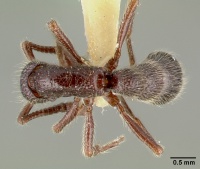Parasyscia centurio
| Parasyscia centurio | |
|---|---|

| |
| Scientific classification | |
| Kingdom: | Animalia |
| Phylum: | Arthropoda |
| Class: | Insecta |
| Order: | Hymenoptera |
| Family: | Formicidae |
| Subfamily: | Dorylinae |
| Genus: | Parasyscia |
| Species: | P. centurio |
| Binomial name | |
| Parasyscia centurio (Brown, 1975) | |
Identification
Keys including this Species
Distribution
Distribution based on Regional Taxon Lists
Afrotropical Region: Democratic Republic of Congo (type locality), Zimbabwe, Zimbabwe.
Distribution based on AntMaps
Distribution based on AntWeb specimens
Check data from AntWeb
Countries Occupied
| Number of countries occupied by this species based on AntWiki Regional Taxon Lists. In general, fewer countries occupied indicates a narrower range, while more countries indicates a more widespread species. |

|
Estimated Abundance
| Relative abundance based on number of AntMaps records per species (this species within the purple bar). Fewer records (to the left) indicates a less abundant/encountered species while more records (to the right) indicates more abundant/encountered species. |

|
Biology
Castes
Images from AntWeb
   
| |
| Worker. Specimen code castype12081-02. Photographer April Nobile, uploaded by California Academy of Sciences. | Owned by CAS, San Francisco, CA, USA. |
Nomenclature
The following information is derived from Barry Bolton's Online Catalogue of the Ants of the World.
- centurio. Cerapachys centurio Brown, 1975: 62, figs. 66-71 (w.) DEMOCRATIC REPUBLIC OF CONGO.
- Type-material: holotype worker, 5 paratype workers.
- Type-locality: holotype Democratic Republic of Congo (“Zaire”): 15 mi. S Kamituga, 700 m., 17.viii.1957 (E.S. Ross & R.E. Leech); paratypes: 2 workers with same data, 3 workers Democratic Republic of Congo (“Zaire”): 29 km. S Walikale, 700 m. (E.S. Ross & R.E. Leech).
- Type-depositories: CASC (holotype); BMNH, CASC, MCZC (paratypes).
- Combination in Parasyscia: Borowiec, M.L. 2016: 204.
- Status as species: Bolton, 1995b: 142.
- Distribution: Cameroon, Democratic Republic of Congo.
Unless otherwise noted the text for the remainder of this section is reported from the publication that includes the original description.
Description
Worker
Holotype: TL 5.7, HL (including frontal lobes) 1.12, HW (immediately behind eyes) 0.83 (CI 74), greatest diameter of eye 0.25, scape L 0.81, WL 1.58, petiolar node L (dorsal view) 0.64, petiolar node W 0.57, postpetiolar node L 0.74, W 0.77 mm.
Paratypes differ only slightly from holotype: TL 5.6-5.7, HL 1.05-1.1 0, HW 0.81-0.84 (CI 75-78), greatest diameter of eye 0.24-0.25 (0.20-0.22 in series from S of Walikale), scape L 0.77-0.80, WL 1.46-1.55, petiolar node L 0.60-0.63, W 0.54-0.56, postpetiolar node L 0.65-0.72, W 0.73-0.77 mm.
Differs from the other African species of the genus in proportions, especially in having petiolar node distinctly longer than broad. Resembling Parasyscia indica in habitus, but with longer head, posterior margin transverse and straight behind in full-face view, sides only gently convex. Anterior face of clypeus lacking median tooth or carina. Foveolae of sculpture smaller than in C indicus and more numerous, crowded, especially on petiole and postpetiole, where the interspaces are finely roughened and the whole surface subopaque. Small punctures on anterior gastric dorsum crowded, but interspaces shining, and posterior part of first segment smooth, with scattered small punctures. Standing hairs also decidedly more abundant than in C. indicus, especially on postpetiole and gaster, where they are strongly inclined toward the rear. Pubescence not developed except for dense, short, reclinate hairs on coxae, lower metapleura, undersurfaces of petiole, front of petiolar node, and antennae.
Antennae with 12 distinct segments; pedicel slightly longer than broad; funicular segments II through IX broader than long; apical segment occupying about 2/5 of length of funiculus, and about 2.5 times as long as wide.
Other minor differences are that in C. centurio, the petiolar node is less narrowed in front than in C. indicus, and has a less sharply produced anterior margin; also, in C. centurio the subpetiolar process is compressed in front, and somewhat pointed as seen from the side, whereas in C. indicus the process is more lobiform and rounded in the same view.
Color dark brown with a slightly reddish tinge (darker than in C. indicus); without bluish iridescence; appendages lighter, more reddish.
Type Material
Holotype (CAS-San Francisco) and 2 paratype workers from 15 miles S of Kamituga, Zaire, 700 m. 17 August 1957 (E. S. Ross and R. E. Leech). Also 3 paratype workers from 29 km S of Walikale, Zaire, 700 m (Ross and Leech). Paratypes in CAS-San Francisco, Museum of Comparative Zoology and BMNH-London. Further material in one or both of these series is available in CAS-San Francisco.
References
- Brown, W. L., Jr. 1975. Contributions toward a reclassification of the Formicidae. V. Ponerinae, tribes Platythyreini, Cerapachyini, Cylindromyrmecini, Acanthostichini, and Aenictogitini. Search Agric. (Ithaca N. Y.) 5(1 1: 1-115 (page 62, figs. 66-71 worker described)
- Borowiec, M.L. 2016. Generic revision of the ant subfamily Dorylinae (Hymenoptera, Formicidae). ZooKeys 608: 1-280 (doi: 10.3897/zookeys.608.9427).
- Chen, Z., Liang, C., Du, C. 2022. Revision of Chinese species of the ant genus Parasyscia Emery, 1882 (Hymenoptera: Formicidae: Dorylinae). Zootaxa 5196(3), 301–330 (doi:10.11646/zootaxa.5196.3.1).
References based on Global Ant Biodiversity Informatics
- Borowiec M. L. 2016. Generic revision of the ant subfamily Dorylinae (Hymenoptera, Formicidae). ZooKeys 608: 1–280.
- Brown W. L., Jr. 1975. Contributions toward a reclassification of the Formicidae. V. Ponerinae, tribes Platythyreini, Cerapachyini, Cylindromyrmecini, Acanthostichini, and Aenictogitini. Search Agric. (Ithaca N. Y.) 5(1): 1-115.

